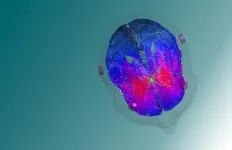(Press-News.org) By Dylan Walsh
Some of human history’s greatest atrocities—genocide, slavery, ethnic cleanings—are rooted in our ability to dehumanize people from other social, political, or cultural groups.
Whereas prior research has traced dehumanization to the belief that others think or feel less than we do, new research co-authored by Haas professor Sameer Srivastava shows that our tendency to dehumanize can also be influenced by how we think others view important facets of the world. The greater the difference between our perceptions of an outgroup’s worldview and those of a “typical” person, the more we tend to dehumanize them.
“The act of dehumanization appears to be at least in part driven by what we refer to as ‘imagined otherness’: the belief that an outgroup perceives of something that one cares deeply about differently than one assumes most other people do,” Srivastava says.
Measuring the space between us
With Austin van Loon from Duke University and Amir Goldberg from Stanford University, Srivastava used the sociological concept of “schemas” to explore this effect. Broadly speaking, schemas refer to the ways in which people categorize the world, as well as the associations that they have between these categories. For example, a conservative in the U.S. might associate freedom with economic independence and lack of government intervention, while a liberal might associate it with civil liberties and the freedom of expression.
In the first of two pre-registered experiments, the researchers recruited self-identified Republicans and Democrats in the U.S. to report on their schemas related to the concept of “America.” Participants chose four words—from a set of eight—that they thought best defined America. Two of these sets contained positive words (e.g. strong, innovative), two contained neutral words (e.g. constitution, western), and two contained negative words (e.g. dangerous, unequal). After articulating their own associations, participants were instructed to characterize the associations that they thought would be made by a prototypical member of their own political party, a typical member of the opposing party, and a typical person.
The researchers then asked participants to report on the extent to which they blatantly dehumanized members of the opposing party. In the first experiment, the researchers found that self-identified members of one party were more likely to blatantly dehumanize members of the opposing party when they thought that group’s worldview about America was very different from what they ascribed to a typical person.
“Of course, the causal arrow could go also go in the opposite direction: The more one dehumanizes an outgroup, the more one might perceive that outgroup as holding views that diverge from a typical human’s,” Srivastava said. To get a clearer understanding of causality, the researchers ran a second experimental study.
In this experiment, Republicans and Democrats were randomly shown one of two sets of fabricated results. One set showed that people in the opposing political party viewed America similarly to the “typical” person. The other showed opposing political party members holding very different schemas from those of the “typical” person. The researchers found that dehumanization was significantly stronger in the latter condition, thereby corroborating results from the first experiment. (Participants were informed about the deception in the experimental design at the end of the study.)
Toward a more humane politics
Srivastava notes that a wealth of research in the past decade has looked at what is called “affective polarization”, or how warmly or coldly we view our political opponents. But this new research gets at something different: “When people view the other side as less than human, we should worry about such negative consequences as political violence,” he says. “If we can start to understand where this perception comes from, it gives us one more lever to combat it.”
He described two potential approaches to reducing how much we dehumanize members of the opposite political party. The first is a simple intervention to correct misperceptions that Republicans and Democrats might have about how the schemas of the other group deviate from those that are typically held. There may be differences, of course, but they may not be as large as people believe them to be.
The second idea would be to use the schemas that partisans hold to craft messaging that both resonates with their worldview and helps them humanize the other side. “The method we developed surfaces the terms that are most strongly associated with the tendency to dehumanize or, conversely, humanize the outgroup,” Srivastava says. “This raises the possibility of strategically avoiding—or proactively using—such terms in messaging that aims to tamp down the dangerous tendency to dehumanize people from the other political party.”
Read the paper:
Imagined otherness fuels blatant dehumanization of outgroups
By Austin van Loo, Amir Goldberg, and Sameer Srivastava
Communications Psychology
May 6, 2024
END
Imagined otherness: Why we dehumanize our political opponents
When we believe that members of another group have beliefs about the world that are at odds with what most others believe, we consider them less human.
2024-05-29
ELSE PRESS RELEASES FROM THIS DATE:
Heart healthy behaviors may help reverse rapid cell aging
2024-05-29
Research Highlights:
The benefits gained from better heart health may be related to a process involved in the aging of the body and its cells, researchers found in a study of more than 5,000 adults with a mean age of 56 years.
People with rapid cell aging may offset the increased risk of heart disease, stroke and death by managing their heart disease risk factors and adopting more heart-healthy behaviors, researchers said.
Embargoed until 4 a.m. CT/5 a.m. ET Wednesday, May 29, 2024
DALLAS, May 29, 2024 — The benefit of better heart health may be associated with the positive impact of heart healthy lifestyle factors on biological aging (the age of the body and its ...
Hitting the target with non-invasive deep brain stimulation: Potential therapy for addiction, depression, and OCD
2024-05-29
Neurological disorders, such as addiction, depression, and obsessive-compulsive disorder (OCD), affect millions of people worldwide and are often characterized by complex pathologies involving multiple brain regions and circuits. These conditions are notoriously difficult to treat due to the intricate and poorly understood nature of brain functions and the challenge of delivering therapies to deep brain structures without invasive procedures.
In the rapidly evolving field of neuroscience, non-invasive brain stimulation is a new hope for ...
The mind after midnight: Study shows disrupted sleep increases risk for suicide and homicide
2024-05-29
An analysis by researchers in the Department of Psychiatry at the University of Arizona College of Medicine – Tucson showed that risks for death by suicide and homicide peak at night, with nocturnal wakefulness, age, alcohol use and relationship conflicts being especially prevalent as contributing factors.
Nearly 19% of suicides and 36% of homicides occur at night. Suicide and homicide share little in common, but their highly concordant overnight risk patterns suggest a common feature: nocturnal ...
Health risk from global warming predictor of city climate action during COVID-19
2024-05-29
City officials were more likely to maintain climate action during the pandemic in places with more climate-related health issues affecting residents.
Cities around the world were more likely to maintain climate action and enact ‘green recovery’ long-term plans after the pandemic if local decision-makers were more alert to the health risks of climate change, a new global study has shown.
The health benefits of tackling climate change, such as cleaner air and more access to green spaces, were key ...
Are there racial inequities in naloxone administration during fatal overdoses?
2024-05-29
Pennsylvania has been disproportionately affected by the opioid epidemic, having the fourth highest number of overdose deaths in the country in 2020. Also, the rate of overdose deaths among Black persons is significantly higher than that of white persons in the state. A recent analysis published in Addiction reveals that compared with white people in Pennsylvania, Black individuals are less likely to receive naloxone—a medication that rapidly reverses an opioid overdose.
In the analysis of 2019–2021 data collected from death ...
Does recreational marijuana legalization affect a state’s college enrollment?
2024-05-29
New research has revealed up to a 9% increase in college freshmen enrollments in US states that have legalized recreational marijuana compared with states without such legalization. The study, which is published in Economic Inquiry, found that the increase was from out-of-state enrollments, with early adopter states and public non-research institutions experiencing the most pronounced increases.
Recreational marijuana legalization did not negatively impact degree completion or graduation rate, and it did not affect ...
Is a train’s risk of derailment affected by its length?
2024-05-29
Longer freight trains are more likely to derail compared with shorter trains, according to new research published in Risk Analysis. The increased risk held even after accounting for the need for fewer trains if more cars were on each train.
For the study, investigators assessed information on US freight train accidents between 2013–2022 from Federal Railroad Administration databases. The team found that running 100-car trains would lead to an 11% higher risk of derailment compared with running 50-car trains, even when accounting for the fact that only half as many 100-car trains would need to run. For 200-car trains, the risk was 24% higher than ...
To what extent are pharmaceutical and illicit drugs contaminating city rivers?
2024-05-29
In research published in Environmental Toxicology & Chemistry, investigators sampled water from 19 locations across the Hudson and East Rivers in 2021 and 2022 to identify and quantify the prescribed pharmaceuticals and drugs of abuse that are making their way into New York City’s rivers and to determine the source of these pollutants.
Metoprolol and atenolol (blood pressure medications), benzoylecgonine (the main metabolite of cocaine), methamphetamine (a stimulant), and methadone (an opioid) were the most prevalent drugs, ...
Solving the problems of proton-conducting perovskites for next-generation fuel cells
2024-05-29
As a newly developed perovskite with a large amount of intrinsic oxygen vacancies, BaSc0.8W0.2O2.8 achieves high proton conduction at low and intermediate temperatures, report scientists at Tokyo Tech. By the donor doping of large W6+, this material can take up more water to increase its proton concentration, as well as reduce the proton trapping through electrostatic repulsion between the dopant and proton. These findings could pave the way to the rational design of novel perovskites for protonic ceramic fuel cells (PCFCs) and electrolysis cells (PCECs).
In line with global efforts towards cleaner energy technologies, fuel cells may soon become an indispensable ...
Bird flu: diverse range of vaccines platforms “crucial” for enhancing human pandemic preparedness
2024-05-29
Vaccination remains the most effective strategy for avian influenza prevention and control in humans, despite varying vaccine efficacy across strains.
That’s according to the authors of a new review which delves into existing research into bird flu vaccines for humans.
Published in the peer-reviewed journal Human Vaccines & Immunotherapeutics, the results of the paper are particularly timely following news last week (Wednesday 22nd May) that the bird flu strain H5N1 had once again, for a second time, jumped from cattle in America to a human – prompting fears of subsequent human-to-human infection, with possible critical consequences.
Instances ...
LAST 30 PRESS RELEASES:
The Journal of Nuclear Medicine ahead-of-print tip sheet: December 12, 2025
Smarter tools for peering into the microscopic world
Applications open for funding to conduct research in the Kinsey Institute archives
Global measure underestimates the severity of food insecurity
Child survivors of critical illness are missing out on timely follow up care
Risk-based vs annual breast cancer screening / the WISDOM randomized clinical trial
University of Toronto launches Electric Vehicle Innovation Ontario to accelerate advanced EV technologies and build Canada’s innovation advantage
Early relapse predicts poor outcomes in aggressive blood cancer
American College of Lifestyle Medicine applauds two CMS models aligned with lifestyle medicine practice and reimbursement
Clinical trial finds cannabis use not a barrier to quitting nicotine vaping
Supplemental nutrition assistance program policies and food insecurity
Switching immune cells to “night mode” could limit damage after a heart attack, study suggests
URI-based Global RIghts Project report spotlights continued troubling trends in worldwide inhumane treatment
Neutrophils are less aggressive at night, explaining why nighttime heart attacks cause less damage than daytime events
Menopausal hormone therapy may not pose breast cancer risk for women with BRCA mutations
Mobile health tool may improve quality of life for adolescent and young adult breast cancer survivors
Acupuncture may help improve perceived breast cancer-related cognitive difficulties over usual care
Nerve block may reduce opioid use in infants undergoing cleft palate surgery
CRISPR primes goldenberry for fruit bowl fame
Mass General Brigham announces new AI company to accelerate clinical trial screening and patient recruitment
Fat tissue around the heart may contribute to greater heart injury after a heart attack
Jeonbuk National University researcher proposes a proposing a two-stage decision-making framework of lithium governance in Latin America
Chromatin accessibility maps reveal how stem cells drive myelodysplastic progression
Cartilaginous cells regulate growth and blood vessel formation in bones
Plant hormone allows lifelong control of proteins in living animal for first time
Swedish freshwater bacteria give new insights into bacterial evolution
Global measures consistently underestimate food insecurity; one in five who suffer from hunger may go uncounted
Hidden patterns of isolation and segregation found in all American cities
FDA drug trials exclude a widening slice of Americans
Sea reptile’s tooth shows that mosasaurs could live in freshwater
[Press-News.org] Imagined otherness: Why we dehumanize our political opponentsWhen we believe that members of another group have beliefs about the world that are at odds with what most others believe, we consider them less human.


